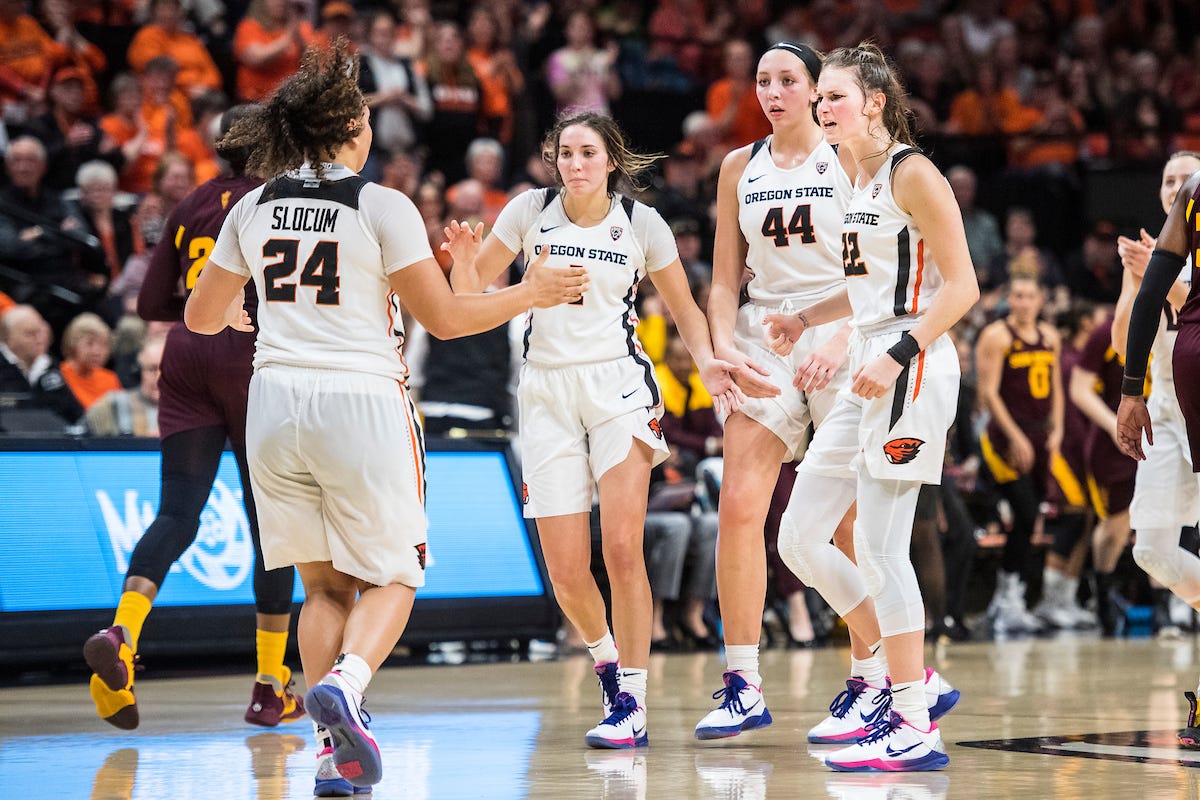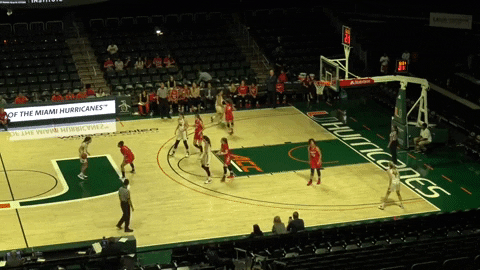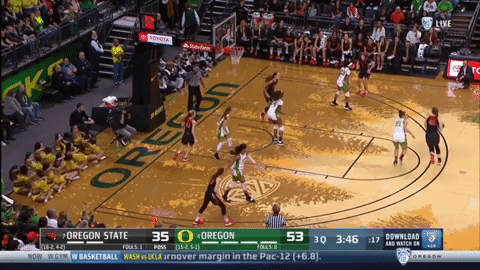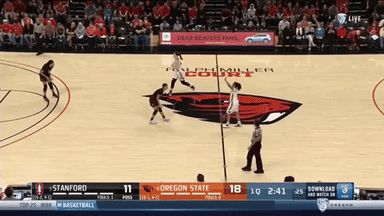Why Destiny Slocum, Aleah Goodman Are Better Together
How one ball, two point guards equal a winning formula for Oregon State
Thanks for reading the Her Hoop Stats Newsletter. If you like our work, be sure to check out our stats site, our podcast, and our social media accounts on Twitter, Facebook, and Instagram. You can also buy Her Hoop Stats gear, such as laptop stickers, mugs, and shirts!
Haven’t subscribed to the Her Hoop Stats Newsletter yet?

CORVALLIS, Ore. — Take your talk of a position battle elsewhere. The No. 17-ranked Oregon State Beavers have two point guards and wouldn’t have it any other way.
Destiny Slocum and Aleah Goodman have the Beavers on track to finish in the top 20 nationally in points scored per 100 possessions for a third consecutive season. The junior guards rank second and third on the team in minutes played behind All-Pac-12 forward Mikayla Pivec and are shooting a combined 40.1 percent on 10.5 3-point attempts per game.
Though they arrived in Corvallis at the same time, Slocum transferred in from Maryland as the national freshman of the year while Goodman was a high-profile in-state recruit. Both grew up tasked with primary ball-handling duties, but they struck up a friendship immediately and understood how this partnership would amplify their other strengths.
“Des and I have an awesome relationship,” Goodman said. “That’s the first piece of it. A lot of people can look at us and want there to be a battle. There was a lot of talk. ‘Who’s gonna be the point guard?’ It’s one of those things where we looked at each other and said, ‘We don’t care.’ Both of us know we can play off the ball. Both of us can handle the ball when we need to. Our relationship is so strong which has allowed us to be even better on the floor.”
“In both of our situations we’ve always been the prime ball-handler,” Slocum said. “We’ve always been the point guard. It’s nice to see our games expand outside of that position. This is the first opportunity I’ve had to play off-ball and to realize, ‘Okay, I can be a wing. I do have these type of wing skills and develop them.’ Both of our goals are to play at the next level, and you’re gonna have to have both 1 skills and 2 and 3 skills, too, to really make it there.”
The makeup of Oregon State’s roster changed after the 2018–19 season. Starting wing Katie McWilliams graduated. Goodman had only drawn three starts but logged north of 25 minutes per contest in part because of a season-ending knee injury to sharpshooting wing Kat Tudor. Slocum and Goodman have started 18 games together this season and have naturally had more time to play together as Tudor was eased back into the mix.
“The opportunity is slightly different with Katie graduating,” Oregon State head coach Scott Rueck said. “Kat coming back impacts it a little bit. To have point guards on the court, the more you have, the better. You have floor leaders that think the game at that level, understand time and score. And with their games, they complement each other. Aleah is more catch and shoot; Destiny is attack and certainly scores well over the top. So it gives us a lot of flexibility. They’re interchangeable which I think is a great look for us because you’re not quite sure where either is gonna be.”
Slocum’s name has come up as a potential early entrant for the WNBA Draft for two seasons now. She saw the merits of the on-court fit with Oregon State over a situation where she could have juiced her numbers leading a more heliocentric attack.
“Most teams only have one person who does everything,” she said. “It’s not like anyone’s finding that person for shots. It’s nice to know when I’m off ball, Aleah’s gonna see me. Both of us have developed a knowledge for our offense so well that we know exactly where people should be, and it helps us make reads faster…When I’m rising out of the corner, I know she’s gonna know I’m there.”
To the credit of the entire Oregon State coaching staff, both players have shown tangible signs of growth while sharing the point guard hat. Goodman, known more for her catch-and-shoot prowess, has become a heady passer who sees windows to fire cross-court lasers to an open shooter.

“This year the game has completely slowed down for me, which has been huge for my passing ability,” she said. “I’ve just been able to see the floor so much better.”
Meanwhile, Slocum has begun processing what it means to be a consistent scoring threat for her team in on-ball situations as she runs into some of the best teams in the country in Pac-12 play.
“My entire life I’ve always come off going, ‘Okay, where are my teammates at? How can I give them the ball?’” she said. “But now you have to be a scorer to draw people’s attention to then create more opportunities for your teammates. It’s been an awesome thing for me because coming off as a scorer is not only gonna mean more opportunity for me to work on my game, but also see my teammates’ offense differently. I would also say I feel like the game is slowing down. I just feel like my reads in my head are faster.”
In part, Slocum and Goodman are such a tantalizing backcourt pairing because they possess one very specific skill: off-the-dribble 3-point shooting. Opponents know they can’t duck under screens with either player. Neither is shy when a shooting window presents itself. Rueck believes this is the most dangerous one of his teams has ever been in that department.
“Time and situation, right? That’s been a part of Destiny’s evolution since she got here,” he said. “What is a good shot? We’ve got a lot of weapons. What is a good shot for you in our system? A lot of it is just understanding defense and manipulating the defense. I think we’re as good as we’ve ever been there…We’re able to execute really well in on-ball situations. It’s tough to go under on those kids because of that.
“That is a skill that I look for in the recruiting process, of course. Not many can do it. Not many can do it well. Those two, it’s like breathing. When I saw Aleah her freshman year in high school just pull back, in and out, cross, pull a three? Wow. That’s a skill that’s so hard to find. That opened my eyes up to her right away.”

“Growing up, I’ve been able to see when I need to shoot and when is the right time to pass,” Goodman added. “We have the green light to pull the trigger when we’re open, but we want the best for our team. If I feel like I have the best shot, I’m gonna shoot.”

Competition at the highest level calls for true shot-makers. The best teams will know your favorite sets and take away the easy reads. Oregon State, a team with preseason Final Four aspirations, is fully aware. You need players that can go hit tough shots over people to make that kind of run.
“We have all the confidence in the world in Des,” Goodman said. “She makes awesome plays. She knows when to give the ball up and then also do her own thing. She’s someone we can count on when we need a bucket.”
Slocum pieced together one of those electrifying shot-making runs when her team hosted Stanford on Jan. 19. She went off for 21 points in the first half on 9-of-13 shooting and scored a game-high 26 points in their second meeting in late February.
“Somebody just has to go score,” Rueck said. “Great teams don’t give you open shots, so you’re gonna have to make contested shots. Destiny has a way of creating space. That’s special. Whether it’s a stepback or off the bounce, or whether it’s using a screen off the ball or on the ball, she’s special in that way. She was phenomenal to open that [Jan. 19 Stanford] game. She’s gonna be a key person for us down the stretch, certainly going on runs like that and then as a playmaker when they send two at her.”
The injury bug has made multiple visits to Corvallis this season. Starting forwards Taya Corosdale (November) and Kennedy Brown (February) both went down with season-ending injuries. The team’s trek through a tough-as-always Pac-12 schedule got tougher.
“The Pac-12 is much different from the Big Ten, if I’m being honest,” Slocum said. “Everyone is more calculated and knows each other very well. That was one thing that’s a little tough. We were playing against great defenses and teams that scouted you just like we scout other teams to the point where they were not gonna let you get to any of your strengths. I think playing a year in it just helped me adapt to, ‘Okay, maybe your reads aren’t just speed. You have to use change of pace in order to get where you need to get.’”
The Beavers have dropped eight games in Pac-12 play and will miss out on a first-round bye in the Pac-12 tournament. A run to a tournament crown in Las Vegas will require four wins in four days. Hosting the first two rounds of the NCAA Tournament as a top-16 seed is far from a certainty.
However, don’t expect the Beavers to give up on their preseason aspirations. They’ve played two one-possession games with Stanford and took UCLA to overtime on their home floor. And who wouldn’t love a third installment of the 2019–20 Civil War with the rival Oregon Ducks, either in the conference tournament or down the line in March?
Despite the injuries and tough losses in Pac-12 play, Slocum and Goodman will continue to lead, putting the Beavers in position to win in March.
All stats obtained from Her Hoop Stats and current as of February 29. Photo via Oregon State Athletics.
Thanks for reading the Her Hoop Stats Newsletter. If you like our work, be sure to check out our stats site, our podcast, and our social media accounts on Twitter, Facebook, and Instagram.



